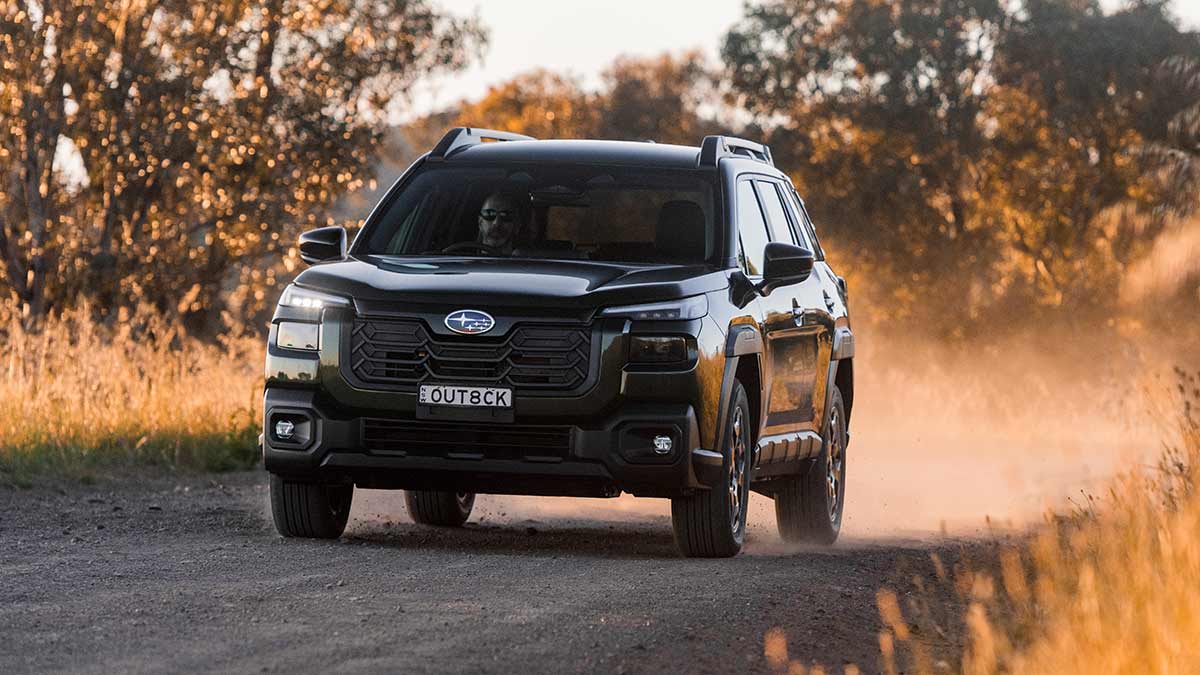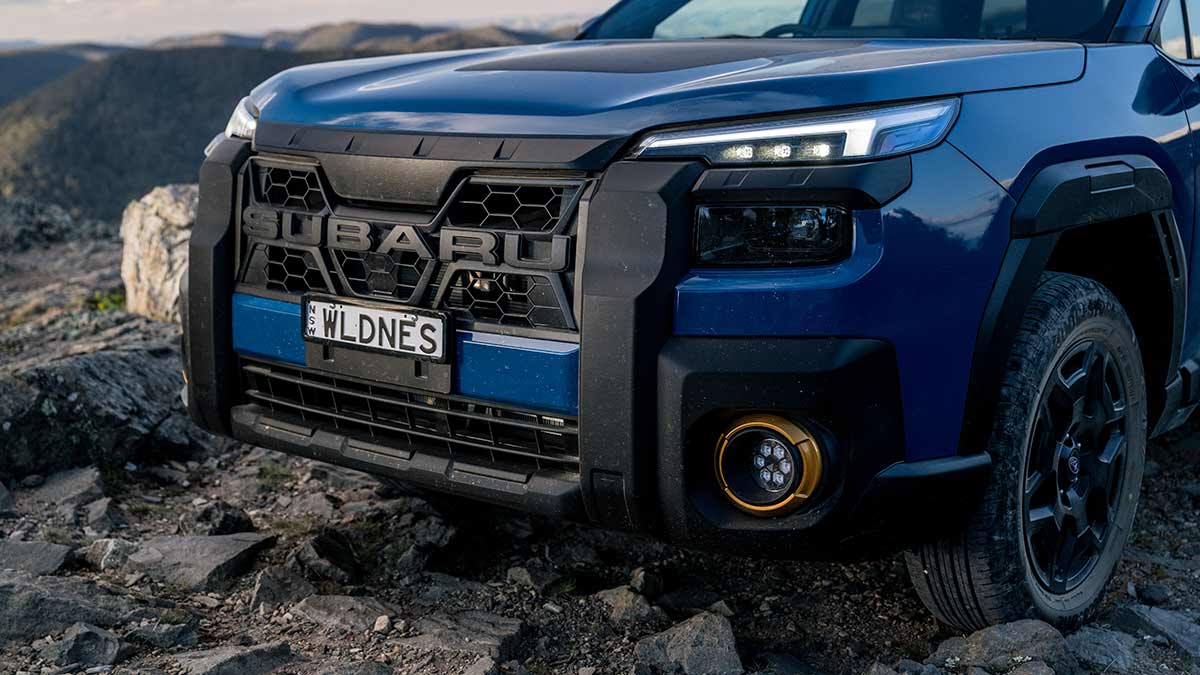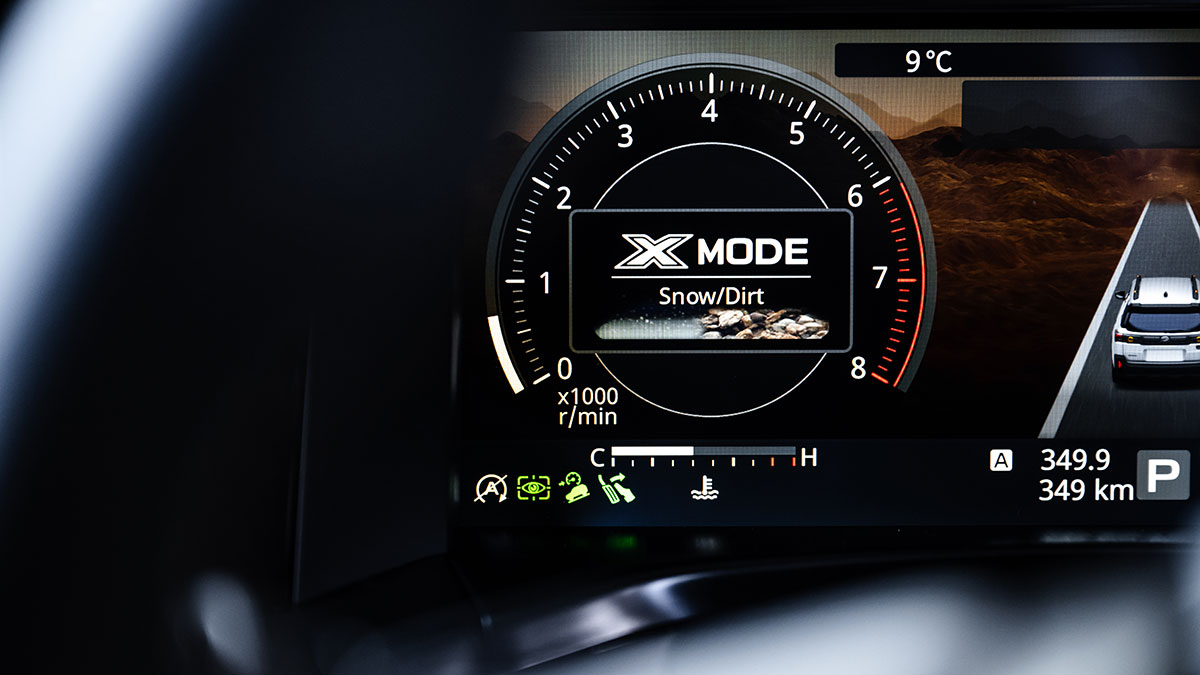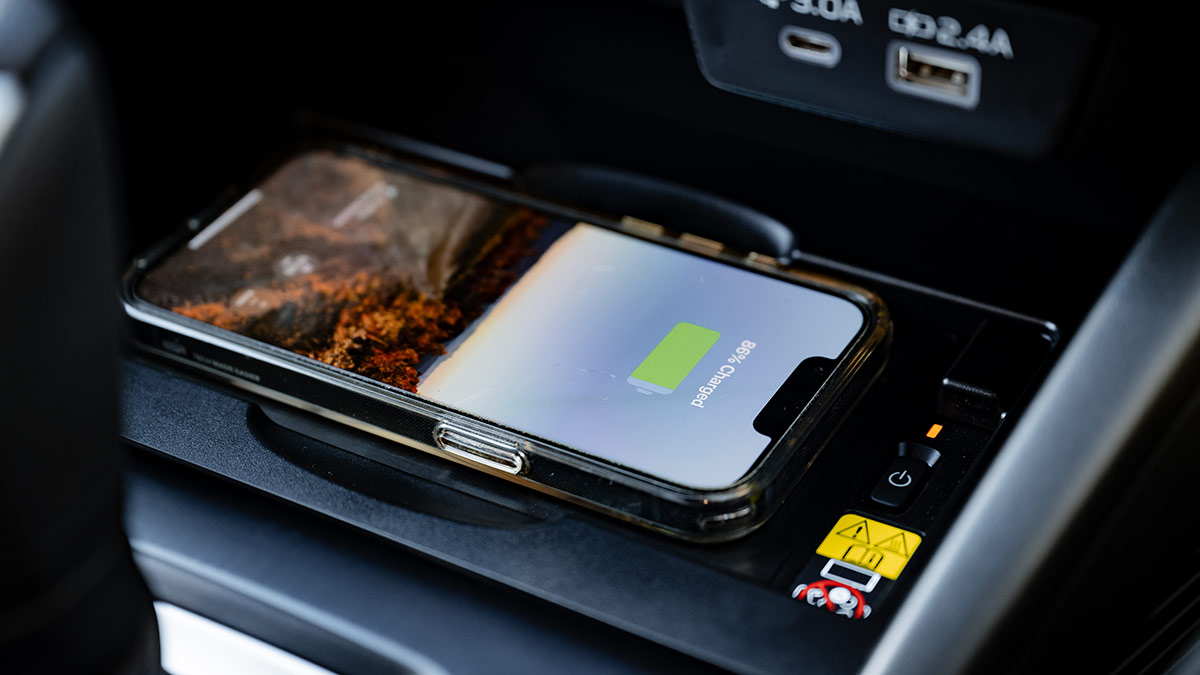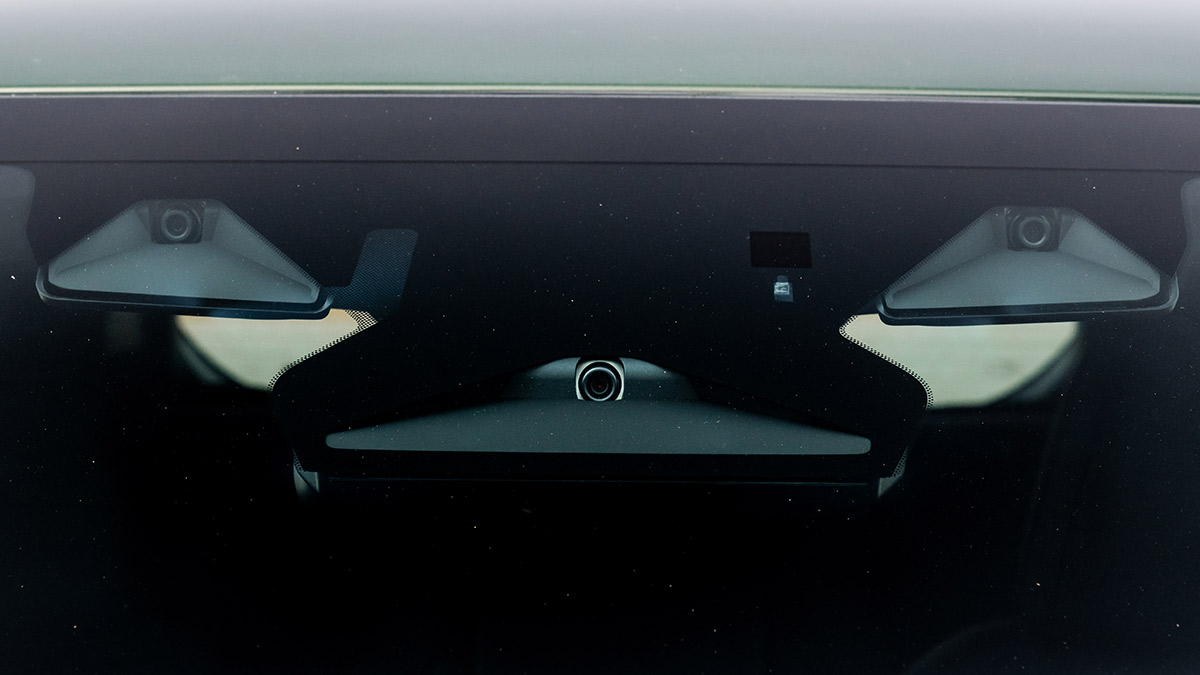Australians buy more SUVs than any other vehicle, so which are the cheapest and most affordable new small, medium, large 7-seater, off-road, hybrid and electric SUVs?
2026 Subaru Outback and Outback Wilderness: price, specs, release date in Australia

The new Subaru Outback is taking the fight up to traditional large SUVs with its bolder looks, broad upgrades and better off-road driving with the first Subaru Outback Wilderness.
The new seventh-generation 2026 Subaru Outback SUV is now on sale in Australia, bringing the long-awaited Outback Wilderness model out of the woods for the first time.
Still with only five seats and going without a hybrid or diesel powertrain option, the new Subaru Outback nonetheless continues to provide an appealing alternative to bigger and more imposing large SUVs like the Toyota Prado and Ford Everest.
Each generational change has seen the Outback grow out from its origins as a high-riding spin-off from the Subaru Liberty, which was axed here in 2020 and has just ended production overseas. This latest iteration stands alone, and with the Subaru Outback Wilderness at the summit, the Japanese brand’s popular all-wheel-drive family wagon finally answers the call from Aussie owners who’ve long wanted better off-road capability.
Subaru Australia is preparing to offer Wilderness models across its SUV range, which includes the Forester and Crosstrek, but has turned the first sod with the new 2026 Subaru Outback.
“Wilderness is not simply a model, it is not just a brand, it is a territory – a territory that we own,” says Subaru Australia general manager Scott Lawrence. “What makes Wilderness so special is core to all of our SUV models – but we have dialled it up, we have awoken something, we have a new halo. What STi means to our performance range, Wilderness is to our SUVs. Think substance, real grit and depth beyond a simple badge on the side of the car.”
So just how capable is the Subaru Outback Wilderness? And can the entire new Outback range regain the dominant position it once held against other large SUV rivals such as the Kia Sorento and Hyundai Santa Fe?
Let’s take a deep dive into the new 2026 Subaru Outback to find out.
More: Research and compare family cars on sale today in Australia
In this article
- When does the 2026 Subaru Outback go on sale in Australia?
- How much does the new Subaru Outback cost?
- 2026 Subaru Outback design and specification
- Subaru Outback model grade equipment levels
- What powers the new Subaru Outback?
- How good is the Subaru Outback Wilderness off-road?
- What safety and technology features on the new Subaru Outback?
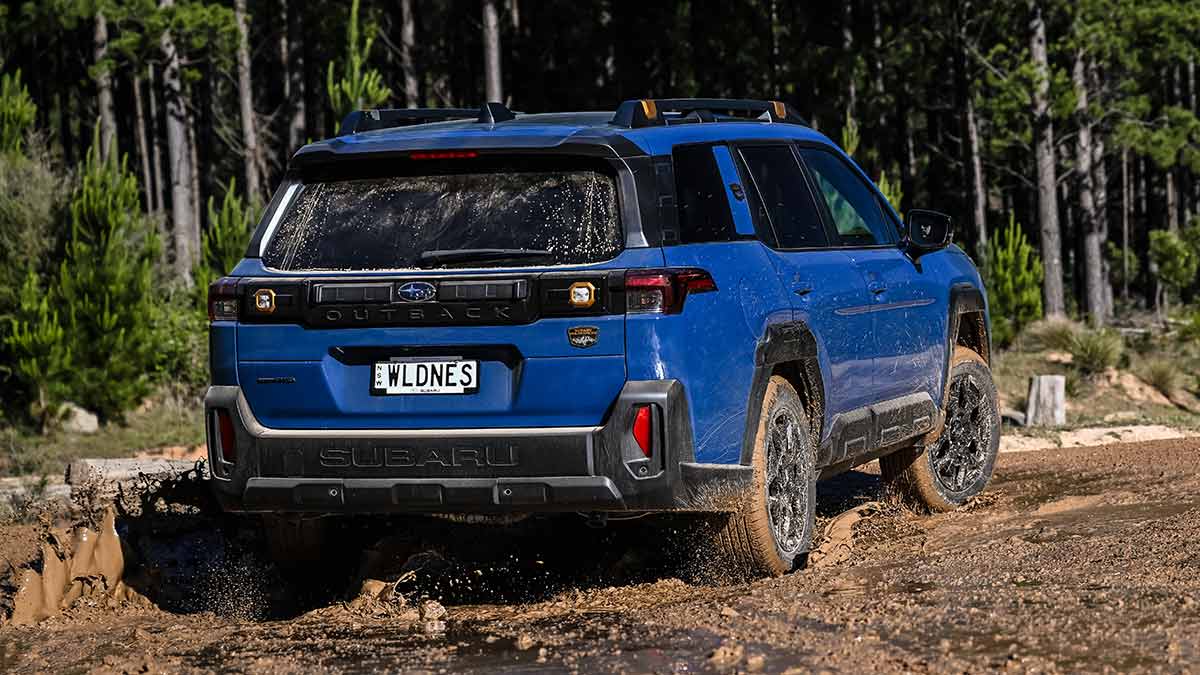
The new 2026 Subaru Outback Wilderness has a selectable X-Mode Deep Snow/Mud terrain setting as part of its off-road arsenal.
When does the 2026 Subaru Outback go on sale in Australia?
The 2026 Subaru Outback is now on sale in Australia with the release of full range pricing. The first examples are entering dealerships as demonstration models, with customer order deliveries expected to commence in the second quarter of 2026.
Subaru Australia recommends that customers contact their local dealer for more information on specific orders and delivery timeframe.
More: Research and compare Subaru Outback variants on sale
How much does the new Subaru Outback cost?
The new 2026 Subaru Outback is priced from $48,990 plus on-road costs, marking a $4800 higher entry point compared to the outgoing series. As with the current Outback, another two grades are offered with the naturally aspirated 2.5-litre four-cylinder petrol ‘boxer’ engine – Premium, which starts from $53,490 (also up $4800 compared to the current Sport) and Touring, which opens at $56,990 plus ORCs (+$4500).
The Outback Sport XT and Touring XT, with a turbocharged 2.4-litre four-cylinder engine, are no longer offered, with Subaru reserving the turbo boxer powerplant for the new Outback Wilderness – in base Wilderness and Wilderness Apex guise. With additional off-road-oriented features, the venture into Wilderness starts $6000 higher than the previous XT, priced from $59,690 (base) and $62,690 for the Apex.
Premium paint adds $660, which refers to eight out of the 10 available colours. Crystal White Pearl and Crystal Black Silica are the no-cost options, leaving Ice Silver Metallic, Magnetite Grey Metallic, Deep Emerald Pearl, River Rock Pearl, Crimson Red Pearl, Brilliant Bronze Metallic, Sapphire Blue Pearl and Geyser Blue.
All models are covered by Subaru Australia’s five-year/unlimited-kilometre new vehicle warranty. Service intervals are every 12 months or 15,000km (whichever comes first) and a capped price servicing scheme is in place for the first five visits back to a Subaru dealership. This costs $2351.21 in total for the 2.5-litre Outback (averaging $470.20 per service) and is a fraction cheaper for the 2.4-litre turbo Outback Wilderness at $2347.31 (av. $469.46).
| 2026 Subaru Outback range | |
|---|---|
|
Subaru Outback AWD |
$48,990 |
|
Subaru Outback AWD Premium |
$53,490 |
|
Subaru Outback AWD Touring |
$56,990 |
|
Subaru Outback AWD Wilderness |
$59,690 |
|
Subaru Outback AWD Wilderness Apex |
$62,690 |

The 2026 Subaru Outback has a new landscape-oriented touchscreen and a large digital instrument display.
2026 Subaru Outback design and specification
Subaru says every line, surface and proportion has been “reimagined” with the 2026 Subaru Outback, and while it does have a boxier new look that’s more like a traditional SUV, it’s built on a revised version of the previous Subaru Global Platform and occupies a similar footprint to the outgoing model.
Key measurements include 2880mm in overall length (+10mm) and 1880mm width (+5mm), resting on an identical 2745mm wheelbase. The new Outback does, however, stand 40mm taller at 1715mm (Wilderness 1735mm), thanks in part to extra ground clearance – now 220mm (+7mm) or 240mm for Wilderness variants.
It also has wider wheel tracks – now out to 1585mm front (+15mm) and 1610mm rear (+10mm) – that ties in with the broader stance and more upright and aggressive front-end design with its larger grille, vertically stacked headlights and chunkier bumpers and cladding around the vehicle. The wider rear pillar is also said to be a sign of strength.
The SUV’s flatter roof is another nod to convention and now employs ladder-type rails with handy reference scales and larger rope hooks for easier positioning of accessories, while the load capacity up top increases to 363kg (+45kg) to better support roof-top tents and the like.
Outback Wilderness models have a unique front bumper, extra cladding, matte black wing mirror caps and anodised copper-look accents on the front fog lamp surrounds, roof rails and details at the rear.
Inside, the new Subaru Outback is claimed to have more room (notably headroom), less noise, better storage facilities and a “calmer, cleaner design”. The centrepiece is the redesigned dashboard that ditches the previous large portrait-oriented touchscreen for a more conventional 12.1-inch screen in landscape position. This is a response to criticism of the outgoing model, which incorporates the climate controls and other main functions into the screen, and can prove frustrating to use.
Now, we’re back to traditional hard-button lower climate controls with rotary dials for easier operation, while Subaru claims the operating system behind the touchscreen is faster and that the menu structure is much simpler. Revised steering wheel controls are also noted, including the X-Mode terrain mode selector moving from the touchscreen to the tiller.
Luggage capacity in the Subaru Outback has increased from 522 litres to 530L (to the ceiling) with the rear seats upright – extending to 1211L with the seats folded – while loading up is easier with a squarer and taller cargo opening. The steeper rear glass angle also improves useable cargo space and the area has a new soft cargo cover than can be redeployed as a mat and stowed away in a side trim pocket when not required. Utility hook anchor points (x8) are found in the luggage compartment for the first time.
The Outback Wilderness models have a 2100kg maximum braked towing capacity, which is down on the 2400kg limit on the turbocharged XT models in the outgoing range – a compromise that won’t please caravanners and other recreational owners who need to tow. Maximum tow ball download is 210kg. The 2.5-litre models remain at 2000kg towing capacity, with a 200kg tow ball download.
2026 Subaru Outback model grade equipment levels
Here is the model grade walk for the new Subaru Outback, starting with the base Outback AWD which has the following headline standard equipment:
- Dual-zone climate control (with rear vents)
- 12.1-inch infotainment touchscreen
- Wireless Apple CarPlay and Android Auto
- Digital radio
- 12.3-inch digital instrument display
- X-Mode terrain mode – Snow/Dirt
- Synthetic black leather seat trim
- Heated front seats
- 8-way power-adjustable driver’s seat with lumbar
- 6-speaker audio system
- Powered tailgate
- Dusk-sensing LED headlights and LED daytime running lights
- 18-inch alloy wheels in dark metallic finish
Outback AWD Premium adds:
- Heated steering wheel
- 8-way power-adjustable front passenger seat
- Panoramic 360-degree view monitor
- Satellite navigation
- Electric sunroof
- 12-speaker Harman Kardon stereo incl. subwoofer and amplifier
Outback AWD Touring adds:
- Nappa leather-accented black seat upholstery (with optional brown trim)
- Wireless phone charging pad
- Auto-folding exterior mirrors with auto-dipping in reverse
- Position memory for driver’s seat and exterior mirrors
- Heated rear outboard seats
- 18-inch machined alloy wheels with gloss finish
Outback AWD Wilderness adds (over base Outback):
- Water-repellent synthetic black seat trim
- Dark black and grey tones with anodised yellow stitching and other details
- Wilderness logo embossed into front head restraints
- Heated steering wheel
- Wireless phone charging pad
- Auto-dimming rearview mirror
- X-Mode – Snow/Dirt and Deep Snow/Mud
- Raised suspension (240mm ground clearance)
- Electronic dampers
- Dual tailpipes
- Unique front LED fog lights
Outback AWD Wilderness Apex adds:
- Electric sunroof
- Satellite navigation
- Panoramic 360-degree monitor
- 12-speaker Harman Kardon audio system
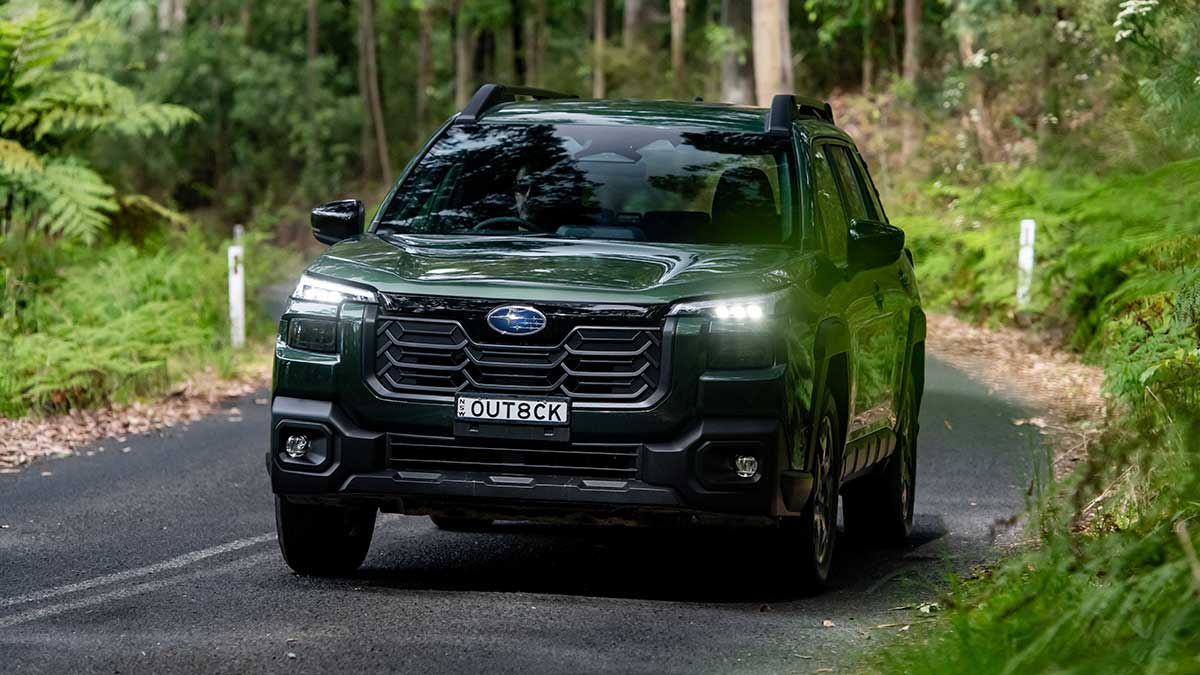
The regular 2026 Subaru Outback relies on a naturally aspirated petrol engine, leaving the turbo to new Wilderness variants.
What powers the new Subaru Outback?
The new 2026 Subaru Outback sticks with the familiar 2.5-litre four-cylinder ‘boxer’ petrol engine and continues to offer a more powerful 2.4-litre turbo in high-grade models, although the latter is now reserved for the Wilderness debutantes.
The latest version of the 2.5-litre four-cylinder produces 137kW of power at 5800rpm (-1kW) and 254Nm of torque at 3700rpm (+9Nm), driving all four wheels through a continuously variable automatic transmission (with eight simulated gears selectable via steering-mounted paddles) and a permanent all-wheel drive system.
The 2.4-litre turbocharged petrol engine found in the Wilderness duo develops 194kW at 5600rpm and 382Nm from 2000-3600rpm – up 11kW and a useful 32Nm compared to the outgoing Outback XT. It also uses an eight-stepped CVT and full-time AWD.
All Outback models have a 63-litre fuel tank and will run on regular 91 RON unleaded fuel. Subaru claims the 2.5-litre Outback models return 8.1L/100km economy on the official lab-based combined cycle, while the 2.4T Wilderness twins are higher at 9.7L/100km.
Weight has a bearing on the consumption, with the 2.5-litre Outback variants tipping the scales at between 1705kg and 1733kg (depending on the grade), while the base-level Wilderness has a 1781kg kerb weight and the flagship Wilderness Apex is a heftier 1802kg.
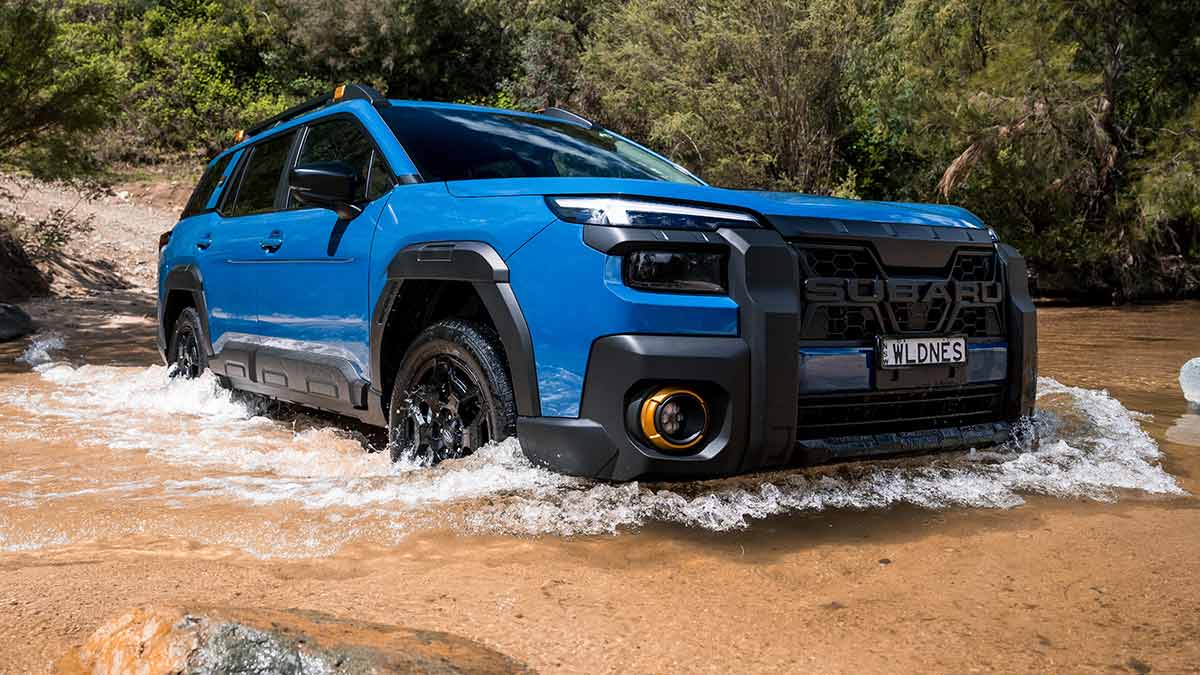
A 240mm ground clearance helps the 2026 Subaru Outback Wilderness negotiate shallow creek crossings.
How good is the Subaru Outback Wilderness off-road?
There’s a lot of hype around just how well-equipped the 2026 Subaru Outback Wilderness is to tackle difficult off-road conditions. Subaru Australia general manager Scott Lawrence declared that the brand’s Wilderness SUVs were all “engineered for customers who prioritise genuine off-road ability and adventure”, but we’re yet to drive the Outback in steep, rock-strewn terrain such as that shown in Subaru’s advertising promos.
As you might expect, Subaru’s all-wheel drive system hasn’t been swapped out for 4WD with low range gearing, locking differentials and the like, so caution is warranted with Aussie outback touring and anything resembling wilderness excursions in the Outback Wilderness.
But the capabilities have increased over the standard Outback with several measures including a higher 240mm ground clearance (+20mm), electronically controlled dampers (tuned for improved stability on rough roads), bumper under-guard, extra body cladding, more durable exterior finishes and enhanced approach, departure and breakover angles – 20, 23.6 and 21.2 degrees respectively (up from 18, 21.4 and 19.4).
Unlike other markets, where unique all-terrain tyres are specified, the Australian-spec Wilderness uses the same road-oriented 225/60R18 Bridgestone Alenza tyres as found on other variants. A full-size spare and a tyre pressure monitoring system are fitted standard across the range.
Subaru’s driver-selectable terrain mode system, known as X-Mode, is fitted to all Outback models, but offers an extra mode on the Wilderness models – Deep Snow/Mud – in addition to the standard Snow/Dirt. It operates at low speeds, adjusting accelerator response, torque delivery and traction control to suit the terrain.
What safety and technology features on the new Subaru Outback?
According to the manufacturer, the 2026 Subaru Outback is a safer vehicle due to a range of modifications, from structural and chassis improvements (including suspension, steering and braking upgrades) to driver positioning and pillar design adjustments (for better visibility) and revised electronic driver assist tech.
The latter includes the latest generation of Subaru’s EyeSight system that incorporates a new wide-angle monocular camera for a better view of pedestrians, cyclists and other road users (working in concert with the stereo camera and front radar).
Key EyeSight features include:
- Emergency driving stop system (new)
- Traffic sign recognition (new)
- Acceleration override assist (new)
- Active lane change assist (new) – on Outback Touring only
- Adaptive cruise control
- Emergency lane keep assist
- Lane centring function and lane sway warning
- Lane departure prevention/warning
- Lead vehicle start alert
- Pre-collision braking and brake assist
- Autonomous emergency steering
- Brake light recognition
- Intelligent speed limiter
The new Subaru Outback also has a new-generation driver monitoring system that is said to improve recognition of facial features (even when wearing a mask) and the detection of impaired seating posture – all in an attempt to provide more accurate alerts for distracted drivers. The outgoing Outback has received criticism for its overzealous alerts and interventions, so we’ll reserve judgement until driving the new model.
Other radar and camera-supported features onboard incudes a new front side radar and the more familiar blind spot monitoring, lane change assist, panoramic 360-degree monitor (not on base Outback or Outback Wilderness), rear cross traffic alert, autonomous emergency braking and rear parking sensors.
All Outback models have nine airbags including a new ‘far-side’ airbag for extra protection of front seat occupants in a side-on collision.
There is no ANCAP safety rating yet for the new Subaru Outback, but the outgoing generation (tested in 2021) was rated as one of the best-performing models to have ever gone through the ANCAP testing regime at the time. Assessment protocols have moved on since then, but a maximum five-star rating is anticipated for the new series.
For infotainment tech, the new landscape-format 12.1-inch high-resolution centre touchscreen integrates with wireless Apple CarPlay and Android Auto connectivity. USB-A and USB-C charging points are provided for front and rear occupants, while Qi wireless smartphone charging pads are provided on higher-series models.
A new 12.3-inch digital instrument cluster also features on the new Outback, offering multiple viewing modes – Classic, EyeSight and Calm, with Map and Projection modes also available on variants fitted with native satellite navigation. Wilderness variants have unique cluster graphics, too.
There are no advanced connected services as found in rival cars, which can offer over-the-air software updates, stolen vehicle tracking, remote functions such as door lock/unlock and cabin temperature pre-set, and automatic collision notification with emergency call (eCall) in the event of a crash.
More: What is eCall and how crash detection technology can save lives
The information provided is general advice only. Before making any decisions please consider your own circumstances and the Product Disclosure Statement and Target Market Determinations. For copies, visit racv.com.au. As distributor, RACV Insurance Services Pty Ltd AFS Licence No. 230039 receives commission for each policy sold or renewed. Product(s) issued by Insurance Manufacturers of Australia Pty Ltd ABN 93 004 208 084 AFS Licence No. 227678.

